#dna double helix
Explore tagged Tumblr posts
Text
"Rosalind Franklin discovered the DNA double helix in 1953, but she never won a Nobel Prize due to sexism.
Years later, Katalin Karikó was kicked out and forced to retire from academia.
Despite this, 70 years after Franklin's discovery, Karikó was awarded the Nobel Prize for developing life-saving #COVID vaccines from another nucleic acid, mRNA."
https://www.reddit.com/r/HermanCainAward/
#rosalind franklin#dna double helix#double helix#dna#october#sexism#nobel prize#Katalin Karikó#covid19#vaccine#vaccines#mrna vaccine#mrna#provaccine#immunology#immunity#immunocompromised#immune health#immune system#health#occupationalhealthandsafety#ausgov#politas#auspol#tasgov#taspol#australia#fuck neoliberals#neoliberal capitalism#anthony albanese
5 notes
·
View notes
Text
Chapters of Life - Evolution: From Chemistry to Complexity
Chapter 1: The Primordial Soup – Where It All Began Once upon a time, about 3.8 billion years ago, the Earth was a very different place. Volcanoes roared, oceans boiled, and the atmosphere was a cocktail of gases. In this seemingly inhospitable environment, a miraculous event occurred – the birth of life from non-life, a process known as abiogenesis. Picture a warm, shallow pool or a deep-sea…
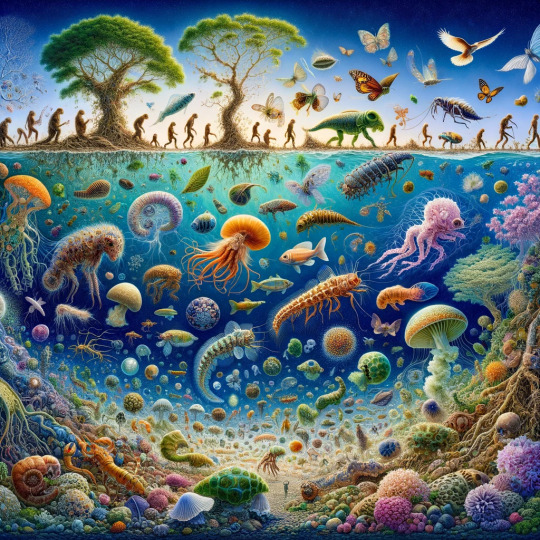
View On WordPress
#abiogenesis#amino acids#biological evolution#cellular specialization#DNA double helix#Earth&039;s ecosystems#endosymbiotic theory#eukaryotic cell evolution#evolution of life#first cells#genetic blueprint#life&039;s diversity#lipid bubbles#molecular biology#multicellular organisms#nucleotides#origin of life#primordial Earth#RNA world hypothesis
2 notes
·
View notes
Text
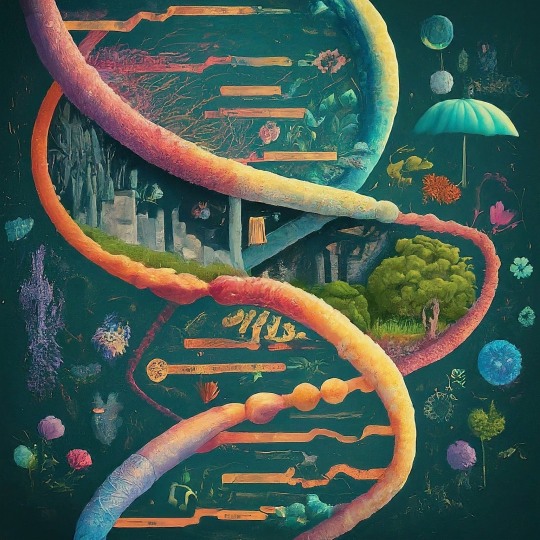
Epigenetics: A Journey Through Inheritance Beyond Genes
For centuries, scientists have been fascinated by the mysteries of heredity and how traits are passed down from generation to generation. DNA, the molecule that stores our genetic code, was once thought to be the sole determinant of our characteristics. However, a new frontier in biology, revealing a captivating layer of complexity beyond the DNA sequence itself: Epigenetics.
What is Epigenetics?
The term "epigenetics" was first coined in the 1940s by British biologist Conrad Waddington, but it wasn't until the late 20th century that its significance truly blossomed. Epigenetics, literally meaning "above genetics," refers to the study of heritable changes in gene expression that occur without alterations to the DNA sequence itself. Imagine DNA as the musical score, but epigenetics are the conductor and musicians who determine how the music is played. Through chemical modifications and adjustments to the proteins around DNA, epigenetics dictates which genes are turned on or off, influencing how cells function and ultimately shaping our health, development, and even behavior. Think of your DNA as the hardware: it contains the basic instructions for building and running your body. But epigenetics acts like the software, fine-tuning those instructions and determining which genes get turned on or off at specific times and in specific cells. These modifications, like chemical tags or changes in the packaging of DNA, don't alter the underlying code itself, but they can have a profound impact on how it's read and interpreted.
The Key Players:
DNA methylation: This process involves adding a methyl group to DNA, essentially silencing the gene it's attached to. Imagine it like putting a dimmer switch on a light bulb.
Histone modifications: Histones are proteins that package DNA, and changes in their structure can make genes more or less accessible to the cellular machinery needed for expression. Think of it like adjusting the curtains around a window - open wide for full light, slightly closed for filtered light.
Non-coding RNAs: These are molecules that don't code for proteins but can regulate gene expression in various ways. They're like the backstage crew in a play, ensuring everything runs smoothly.
The Power of Epigenetic Regulation
Epigenetic regulation plays a crucial role in various biological processes, including:
Development: During embryonic development, different cell types emerge from the same DNA blueprint by activating or silencing specific gene sets through epigenetic modifications.
Cellular differentiation: Specialized cells like muscle or nerve cells have unique functions due to differences in their active genes, controlled by epigenetic mechanisms.
Learning and memory: Epigenetic changes in brain cells are thought to be essential for learning and forming memories.
Aging: As we age, our epigenome accumulates changes that can contribute to age-related decline and disease.
Environmental influences: Diet, exercise, stress, and exposure to toxins can leave epigenetic marks on our genes, potentially impacting our health and even the health of future generations.
Epigenetics reminds us that we are not simply products of our genes. Our environment, choices, and experiences leave their mark, shaping who we are and potentially influencing our children's health. This deeper understanding of ourselves opens doors for self-awareness, empowerment, and potentially reshaping our narratives – not just as individuals, but as a species with the potential to leave a healthier legacy for generations to come.
#life science#biology#science sculpt#molecular biology#biotechnology#epigenetics#daily dose of science#dna#genetic inheritance#genetics#decoding dna#genetic code#science#double helix
124 notes
·
View notes
Photo

James Watson (left) and Francis Crick with their double helix DNA model at the Cavendish Laboratories. Cambridge University. 1953.
I Am Collective Memories • Follow me, — says Visual Ratatosk
#BW#Black and White#Preto e Branco#Noir et Blanc#黒と白#Schwarzweiß#retro#vintage#James Watson#Francis Crick#double helix#DNA model#DNA#Cavendish Laboratories#Cambridge University#1953#1950s#50s#portrait#肖像#画像#retrato#Porträt#history#histoire#história#Geschichte#歴史#historical#historisch
66 notes
·
View notes
Text
Ghosts having DNA is actually so fucked up and I KNOW they probably put about two seconds of thought into it when they made Danny Phantom but I'M THINKING ABOUT IT NOW AND WHAT THE HELL
#danny phantom#are ghosts just another type of organism???#are ghosts able to reproduce?#do they undergo mitosis and meiosis??#what the HELL#ALSO#WHERE DID DANNY GET HIS GHOST DNA FROM?#does he have like a ghost parasite? WHO is that guy in the title sequence diving into his double helix?
45 notes
·
View notes
Note
Hello hi!! May we have a stimboard centered around G1 Shockwave? Ideally with purple stims, themed around science and maybe a few jurassic park things? thx in advance !! we absolutely adore your stimboards 🫶










Shockwave (Transformers) with purple science and Jurassic Park!
🧬|🟣|🧬 🟣|🧬|🟣 🧬|🟣|🧬
#weheartstims#stimboard#shockwave#g1 shockwave#transformers#transformers g1#purple#science#jurassic park#dinosaurs#dna#double helix#chemicals#beaker#beakers#pouring#plasma ball#electricity#fire#fire tw#dry ice#smoke#test tubes
34 notes
·
View notes
Photo
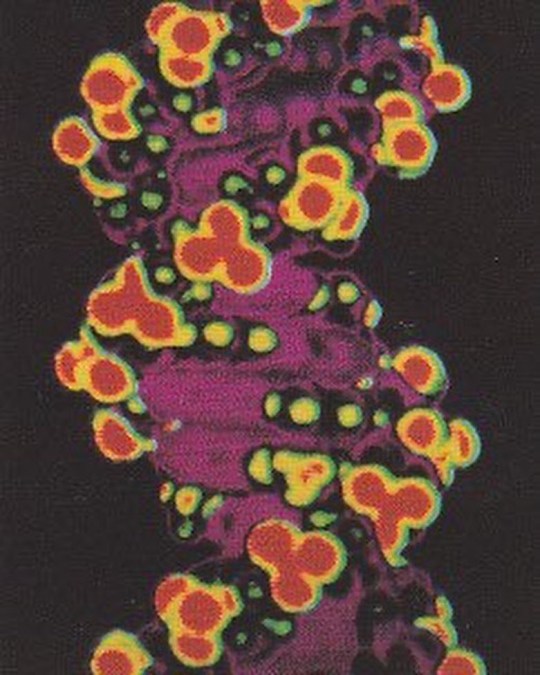
Ryan Mitchell
376 notes
·
View notes
Text
thinking about the genetics lab i'm gonna be taking this fall and once again having that "if hawkeye can do this difficult science stuff then i can too" moment and just like last time i started thinking "wait did he though?" and well folks, this man did not even get to find out what DNA looks like until a couple months before he went home
#i know the mail is slow but i assume articles on something like the dna double helix would be able to get there in time. maybe#would be funny if he got home and all his stateside colleagues are like DUDE DID YOU HEAR? DNA LOOKS COOL AS FUCK and he's like ?!?!?! WHAT#WHAT ELSE DID I FUCKING MISS?????#shebbz shoutz
43 notes
·
View notes
Text

Rafał Olbiński
#Rafał Olbiński#art#surreal#space#cosmos#universe#stars#galaxy#trippy#lighthouse#dna#double helix#planets#comet#surrealism#surreal art#map#geography
133 notes
·
View notes
Text


#Fractal DNA#DNA#fractal#fractals#helix#Deoxyribonucleic acid#double helix#AI art#AI#art#biology#Microsoft
3 notes
·
View notes
Text
"It's beautiful," Crick breathes, erect and standing while admiring the erect and standing model of double-helix DNA, all bases correctly paired as the metal pieces spin a frozen tower heavenward, reaching. Reaching like humanity grasping for God, but now they've finally reached divinity. Once a project of babel, now solved. Finally, it's complete. "Crick," says Watson in that quick way of his, chewing at nothing. "Your crick, is, well, cricked. Your wank is cranked." "Watson, you. God's sake for the last time stop looking at my penis"

#race to the double helix#james watson#francis crick#dna#writing#this is what happened#to me#jeff goldblum
7 notes
·
View notes
Text
For the most part, I've gotten fewer weird-ass answers from students on their worksheets as the semester goes on. And then this week, we had DNA and Inheritance, and there was a question about dominant traits and does dominant allele mean higher fitness- and let me tell you, that question's answers are a mess. Some I'm just staring at and going....there are a lot of words here that are completely wrong, do I give any points?
anyway the course coordinator is going to be getting feedback on that question tomorrow, it was worded poorly and we needed more slides to cover it more clearly. Some students did perfectly, but others are. uh. Didn't get the memo.
#it is so hard to anticipate what people are going to struggle with#there's a lot that is just basic common stuff to me and it is apparently not common knowledge#was never going to be able to anticipate people un-crossing the test tube tongs#and trying to remove hot test tubes from a water bath with the curved sides of the tongs pointed in#or people making a prediction about what extracted strawberry DNA would look like#and saying 'it will be a double helix'#y'all thought that you would be able to see the double helix with your bare eyes?
16 notes
·
View notes
Text

A bronze statue of a laboratory mouse knitting a double helix of DNA in order to honor all the mice that were sacrificed for genetic research to develop new drugs to fight diseases.
It was designed by Andrew Kharkevich and is located in Siberia, Russia.
The monument was completed on 1 July 2013, coinciding with the 120th anniversary of the founding of the city.
The monument commemorates the sacrifice of the mice in genetic research used to understand biological and physiological mechanisms for developing new drugs and curing diseases.
Sculptor Alexei Agrikolyansky, who created the statue, confessed that it was challenging to capture this moment, as the mouse was obviously not human.
Nevertheless, he had to produce a character with believable emotions while maintaining anatomical proportions, avoiding it looking like a cartoon character or a real mouse.
The DNA spiral emerging from the knitting needles winds to the left, symbolizing the still poorly understood Z-DNA - representing the scientific research that is yet to be done.
In contrast, the more common B-DNA winds to the right.
The very first photograph of DNA was captured by a woman named Rosalind Franklin (25 July 1920 – 16 April 1958) using X-ray technology, allowing James Dewey Watson (born April 6, 1928) and Francis Harry Compton Crick OM FRS (8 June 1916 – 28 July 2004) to accurately characterize the double helix.
While they went on to win the Nobel Prize in Physiology or Medicine in 1962, Franklin was not credited.
Sadly, she had passed away in 1958 from ovarian cancer, most likely caused by the high radiation exposure she endured while working with X-rays to capture the image of the double helix.
🤎🤍🤎
#DNA#mice#genetic research#Andrew Kharkevich#Alexei Agrikolyansky#scientific research#Z-DNA#B-DNA#Rosalind Franklin#James Dewey Watson#Francis Harry Compton Crick#double helix#Nobel Prize#science#Nobel Prize in Physiology or Medicine#laboratory mouse
18 notes
·
View notes
Text
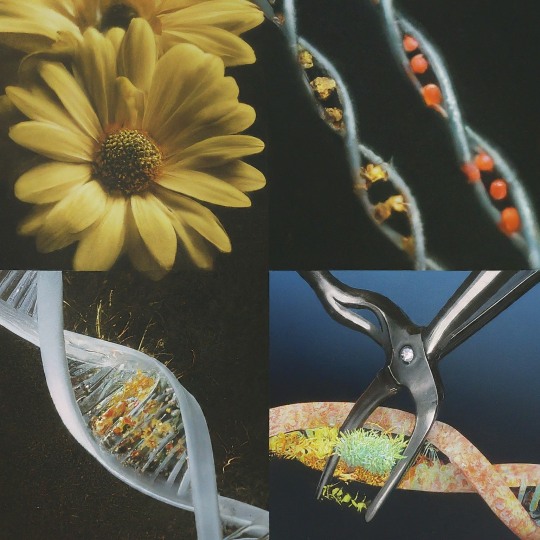
A snip, a splice : Power of rDNA Technology
Deoxyribonucleic acid (DNA), the blueprint of life, holds the secrets to the intricate workings of every living organism. But what if we could manipulate this blueprint, adding, removing, or tweaking its code? This revolutionary concept forms the core of recombinant DNA (rDNA) technology, a powerful tool that has transformed biology and medicine.
The story starts in the early 1970s with two brilliant scientists; Stanley Cohen at Stanford University and Herbert Boyer at the University of California, San Francisco. Cohen, a microbiologist, had been studying plasmids – small circular DNA molecules found in bacteria. Boyer, a biochemist, was an expert on restriction enzymes – molecular scissors that could cut DNA at specific sequences. Their collaboration proved groundbreaking. They envisioned combining these tools to create the first ever recombinant DNA molecule. Cohen provided the plasmids, which would act as vectors to carry foreign DNA into host cells. Boyer, on the other hand, used restriction enzymes to cut both the plasmid and the desired foreign DNA, allowing them to be pieced together. Through meticulous experimentation, they successfully created the first recombinant DNA molecule, forever altering the course of biology.
Cohen and Boyer's work wouldn't have been possible without the earlier discoveries of restriction enzymes. These "molecular scissors" were independently identified by three separate research groups in the 1960s. Werner Arber in Switzerland, along with Hamilton Smith and Daniel Nathans in the US, unraveled the role of restriction enzymes in bacterial defense mechanisms. These enzymes helped bacteria defend against invading viruses by cutting up their foreign DNA. Recognizing the potential of these "genetic scalpels," the groundwork was laid for their application in rDNA technology.
Here's a simplified breakdown of the rDNA process:
Isolation of DNA: The journey starts with isolating DNA from a donor organism.
Cleavage with Restriction Enzymes: Specific enzymes cut the DNA at defined sequences.
Selection of Vector: A carrier molecule (often a plasmid) is chosen to transport the recombinant DNA.
Ligation: The DNA fragments and vector are stitched together using DNA ligase, an enzyme.
Transformation: The recombinant DNA enters a host cell (usually bacteria or yeast).
Selection and Expression: The transformed cells are selected, and the gene of interest is expressed, leading to the desired protein production.
Since its inception, rDNA technology has played a pivotal role in several groundbreaking advancements. Let's take a whirlwind tour through some of the most significant moments in R-DNA history:
1978: Birth of Insulin on the Factory Floor: Scientists achieved a feat of genetic engineering by using R-DNA to produce human insulin in bacteria. This marked a turning point for diabetics, offering a readily available and more consistent source of this life-saving hormone.
1980s: Gene Wars and the Rise of GMOs: The 1980s saw the development of genetically modified organisms (GMOs). Plants were engineered with genes for insect resistance or herbicide tolerance, sparking debates about the safety and ethics of this technology. R-DNA research continues to be at the forefront of discussions regarding genetically modified foods.
1990s: The Human Genome Project Sets Sail: This ambitious international project aimed to sequence the entire human genome. R-DNA techniques played a crucial role in deciphering the 3 billion letters of our genetic code, opening doors for personalized medicine and a deeper understanding of human health and disease.
2000s: Gene Therapy Takes Center Stage: The first successful gene therapy trials for inherited diseases like severe combined immunodeficiency (SCID) took place. R-DNA technology offered a glimmer of hope for treating genetic disorders by introducing healthy genes to replace defective ones.
2010s and Beyond: CRISPR Takes Over: The emergence of CRISPR-Cas9, a revolutionary gene editing tool based on R-DNA principles, has ushered in a new era of genetic manipulation. With unprecedented precision, scientists can now edit genes in various organisms, holding immense potential for gene therapy, crop improvement, and even the eradication of diseases.
But with great power comes great responsibility, and R-DNA raises a host of ethical concerns.Tinkering with the building blocks of life carries the risk of unintended consequences. Engineered genes could escape and disrupt ecosystems, or modified organisms could have unforeseen health effects. The ability to edit human genes opens the door to designer babies, raising questions about social equity and the potential misuse of the technology for eugenics.
Who Controls the Tools? Access to R-DNA technology could be restricted to wealthy nations or corporations, exacerbating existing inequalities. Biosecurity is also a concern, as the technology could be misused for bioterrorism. Creating entirely new organisms forces us to confront what it means to be "natural." Should we modify plants and animals for human benefit, or preserve their original forms? R-DNA technology is a powerful tool, and we must have open discussions about its ethical implications. Scientists, policymakers, and the public all need to be involved in shaping the future of this technology. As we move forward, open dialogue and collaboration between scientists, policymakers, and the public are crucial to ensure the safe and ethical application of this powerful technology.
The journey of rDNA technology is a testament to human ingenuity and its potential to reshape our world. From decoding the secrets of life to creating solutions for healthcare, agriculture, and beyond, rDNA technology continues to evolve, promising a future filled with exciting possibilities.
#science sculpt#life science#science#molecular biology#biology#biotechnology#artists on tumblr#dna#double helix#genetics#recombinant#genetic engineering#insulin#research#education#learning#academics#scientific research#scientific illustration#medical science#scifi#daily dose of science#scientific advancements#scientific tools#medical school
16 notes
·
View notes
Text
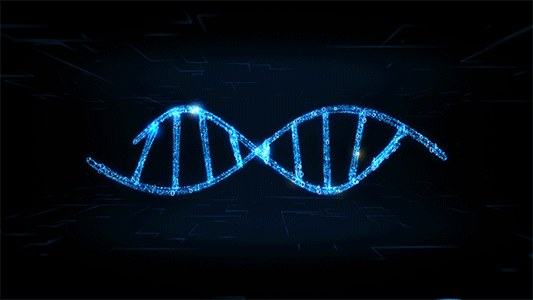
The future of DNA in the cloud? Watch it in 4K on here: https://www.youtube.com/watch?v=JsX9q59odNM
#gif#animated gif#gif animation#mograph#motion graphics#motion design#animation#c4d#particles#xparticles#glowing#double helix#helix#dna#strand#molecule#molecular#biology#ai#artificial intelligence#futuristic#dna strand#crispr#crisper#hologram#cyberspace#digital#data#technology#medicine
9 notes
·
View notes
Text
Question: What did James Watson and Francis Crick (and Maurice Wilkins) discover?
Answer: Rosalind Franklin's notes.
9 notes
·
View notes